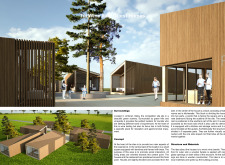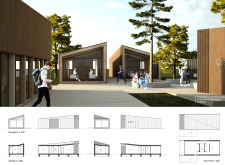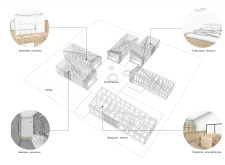5 key facts about this project
The primary function of the project is to accommodate visitors seeking a connection with the local wine culture, offering comfortable living spaces that encourage leisure and socialization. The layout promotes easy movement between units and shared areas, creating a welcoming environment for guests. The architectural design effectively balances communal and private spaces, allowing for both social gatherings and personal retreat.
Unique Design Approaches
One notable aspect of the project is its architectural inspiration drawn from traditional wine barrels. The sloped roofs of the guest homes reflect this element, integrating local agricultural heritage into the modern design. The use of natural wood for the exterior cladding establishes a warm aesthetic that resonates with the surrounding landscape, while large glass openings enhance the visual connection between indoors and outdoors.
The project incorporates sustainable practices by utilizing locally sourced materials, thereby minimizing environmental impact and fostering a sense of place. The alignment of the homes allows for optimal views of the vineyards, reinforcing the connection between the architecture and its context.
Materials used include natural wood, glass, and concrete, chosen for their durability and ability to blend with the local environment. The design also prioritizes accessibility, with clear pathways leading to communal areas, ensuring that all guests can navigate the space comfortably.
Architectural Elements and Spatial Organization
The overall layout features individual guest homes arranged around a central square, fostering interaction while maintaining privacy. Each unit is equipped with essential amenities, including kitchenettes and bathrooms, while providing flexible living spaces conducive to relaxation and socializing. These practical features underscore the project’s focus on enhancing the visitor experience.
The architectural plans reflect a commitment to functionality and aesthetic coherence, utilizing simple yet effective design techniques. The harmonious blend of tradition and modernity creates a unique ambiance that distinguishes Tili Wine from other architectural projects in wine tourism.
Readers are encouraged to explore the architectural plans, sections, and designs of the Tili Wine guest homes project for a more comprehensive understanding of its design principles and innovative ideas.


























